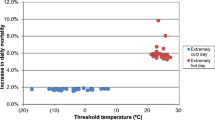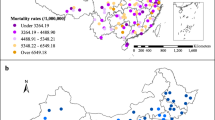Abstract
Extreme heat is a significant public health challenge in urban environments that disproportionally impacts vulnerable members of society. In this research, demographic, economic and climate projections are brought together with a statistical approach linking extreme heat and mortality in Houston, Texas. The sensitivity of heat-related non-accidental mortality to future changes of demographics, income and climate is explored. We compare climate change outcomes associated with two different Representative Concentration Pathways (RCPs), RCP4.5 and RCP8.5, which describe alternate future scenarios for greenhouse gas emissions and concentrations. For each RCP, we explore demographic and economic scenarios for two plausible Shared Socioeconomic Pathways (SSPs), SSP3 and SSP5. Our findings suggest that non-accidental mortality in 2061–2080 may increase for all combinations of RCP and SSP scenarios compared to a historical reference period spanning 1991–2010. Notably, increased heat-related non-accidental mortality is associated with changes in the size and age of the population, but the degree of sensitivity is highly uncertain given the breadth of plausible socioeconomic scenarios. Beyond socioeconomic changes, climate change is also important. For each socioeconomic scenario, non-accidental mortality associated with the lower emissions RCP4.5 scenario is projected to be 50 % less than mortality projected under the higher emissions RCP8.5 scenario.



Similar content being viewed by others
References
Anderson GB, Bell ML (2011) Heat waves in the United States: mortality risk during heat waves and effect modification by heat wave characteristics in 43 US communities. Environ Health Perspect 119:210–218
Borden KA, Cutter SL (2008) Spatial patterns of natural hazards mortality in the United States. Int J Health Geogr. doi:10.1186/1476-072X-7-64
Chen F, Dudhia J (2001) Coupling an advanced land surface hydrology model with the Penn State-NCAR MM5 modeling system. Part 1: model implementation and sensitivity. Mon Weather Rev 129:569–585
Chen F et al. (2007) Description and evaluation of the characteristics of the NCAR high-resolution land data assimilation system. J Appl Meteorol Climatol 46:694–713. doi:10.1175/JAM2463.1
Ching J et al. (2009) National Urban Database and access portal tool. B Am Meteorol Soc 90:1157–1168. doi:10.1175/2009BAMS2675.1
Conlon K, Monaghan AJ, Hayden MH, Wilhelmi O (2016) Potential impacts of future climatic and land use changes on intra-urban heat exposure in Houston, Texas. PLoS One 11:e148890
Cosgrove BA et al. (2003) Real-time and retrospective forcing in the north American land data assimilation system (NLDAS) project. J Geophys Res 108:8842. doi:10.1029/2002JD003118
Curriero FC, Heiner KS, Samet JM, Zeger SL, Strug L, Patz JA (2002) Temperature and mortality in 11 cities of the eastern United States. Am J Epidemiol 155:80–87
Diffenbaugh NS, Ashfaq M (2010) Intensification of hot extremes in the United States. Geophys Res Lett 37:L15701. doi:10.1029/2010GL043888
Duffy PB, Tebaldi C (2012) Increasing prevalence of extreme summer temperatures in the U.S. Clim Chang 111:487–495. doi:10.1007/s10584-012-0396-6
Emerson MO, Brater J, Howell J, Wilner Jeaenty P, Cline M (2013) Houston region grows more racially/ethnically diverse, with small declines in segregation. Kinder Institute for Urban Research & Hobby Center for the Study of Texas. http://kinder.rice.edu/uploadedFiles/Urban_Research_Center/Media/Houston%20Region%20Grows%20More%20Ethnically%20Diverse%202-13.pdf. Accessed 25 July 2015
Greater Houston Partnership Research Department (GHPRD) (2014) Social, Economic and demographic characteristics of metro Houston. http://www.houston.org/pdf/research/quickview/Population_Employment_Forecast.pdf. Accessed 30 July 2015
Greene S, Kalkstein LS, Mills DM, Samenow J (2011) An examination of climate change on extreme heat events and climate–mortality relationships in large U.S. cities. Weather Climate Soc 3:281–292. doi:10.1175/WCAS-D-11-00055.1
Heaton MJ, Sain SR, Greasby TA, Uejio CK, Hayden MH, Monaghan AJ, Boehnert J, Sampson K, Banerjee D, Nepal V, Wilhelmi OV (2014) Characterizing urban vulnerability to heat stress using a spatially varying coefficient model. Spatial Spatiotemporal Epidemiol 8:23–33
Homer CG, Huang C, Yang L, Wylie B, Coan M (2004) Development of a 2001 national land-cover database for the United States. Photogramm Eng Rem S 70:829–840
Hurrell JW et al. (2013) The community earth system model: a framework for collaborative research. B Am Meteorol Soc 94:1339–1360
IIASA (International Institute for Applied Systems Analysis) (2015) SSP Database (Shared Socioeconomic Pathways) - Version 0.9.3. https://secure.iiasa.ac.at/web-apps/ene/SspDb/dsd?Action=htmlpage&page=about. Accessed 17 March 2015
IPCC (Intergovernmental Panel on Climate Change) (2013) Climate Change 2013: The Physical Science Basis. In: Stocker TF, Qin D, Plattner G-K, Tignor M, Allen SK, Boschufng J, Nauels A, Xia Y, Bex V, Midgley PM (eds) Contribution of Working Group I to the Fifth Assessment Report of the Intergovernmental Panel on Climate Change. Cambridge University Press, Cambridge
Jiang L, O’Neill, BC (2009) Household projections for rural and urban areas of major regions of the world. IIASA Interim Report IR-09-026. Laxenburg
Jones TS et al. (1982) Morbidity and mortality associated with the July 1980 heat wave in St. Louis and Kansas City, Mo. J Am Med Assoc 247:3327–3331
Kay JE et al. (2014) The Community Earth System Model (CESM) Large Ensemble Project: A community resource for studying climate change in the presence of internal climate variability. B Am Meteorol Soc. doi:10.1175/BAMS-D-13-00255.1
KC S, Lutz W (2014) The human core of the shared socioeconomic pathways: Population scenarios by age, sex and level of education for all countries to 2100. Glob Environ Chang. doi:10.1016/j.gloenvcha.2014.06.004
Knutti R, Masson D, Gettelman A (2013) Climate model genealogy: generation CMIP5 and how we got there. Geophys Res Lett 40:1194–1199. doi:10.1002/grl.50256
Kusaka H, Kondo H, Kikegawa Y, Kimura F (2001) A simple single-layer urban canopy model for atmospheric models: comparison with multi-layer and slab models. Bound-Layer Meteorol 101:329–358
Li D, Bou-Zeid E (2013) Synergistic interactions between urban heat islands and heat waves: the impact in cities is larger than the sum of its parts. J Appl Meteorol Clim 52:2051–2064. doi:10.1175/JAMC-D-13-02.1
Medina-Ramon M, Zanobetti A, Cavanagh DP, Schwartz J (2006) Extreme temperatures and mortality: assessing effect modification by personal characteristics and specific cause of death in a multi-city case only analysis. Environ Health Persp 114:1331–1336
Meehl GA, Tebaldi C (2004) More intense, more frequent, and longer lasting heat waves in the twenty-first century. Science 305:994–997. doi:10.1126/science.1098704
Mesinger F, DiMego G, Kalnay E, et al. (2006) North American regional reanalysis. B Am Meteorol Soc 87:343–360
Monaghan AJ, Hu L, Brunsell NA, Barlage MJ, Wilhelmi OV (2014) Evaluating the impact of urban morphology configurations on the accuracy of urban canopy model temperature simulations with MODIS. J Geophys Res 119:6376–6392. doi:10.1002/2013JD021227
O’Neill BC, Kriegler E, Riahi K, Ebi KL, Hallegatte S, Carter TR, Mathur R, van Vuuren DP (2014) A new scenario framework for climate change research: the concept of shared socioeconomic pathways. Clim Chang 122:387–400
O’Neill BC, Ebi KL, Kemp-Benedict E, et al. (2015) The roads ahead: narratives for the Shared Socioeconomic Pathways describing world futures in the twenty-first century. Glob Environ Chang. doi:10.1016/j.gloenvcha.2015.01.004
Oleson KW, Monaghan A, Wilhelmi O, Barlage M, Brunsell N, Feddema J, Hu L, Steinhoff DF (2015a) Interactions between urbanization, heat stress, and climate change. Clim Chang 129:525–541. doi:10.1007/s10584-013-0936-8
Oleson KW, Anderson GB, Jones B, McGinnis SA, Sanderson B (2015b) Avoided impacts of urban and rural heat and cold waves over the U.S. using large climate model ensembles for RCP8.5 and RCP4.5. Clim Chang 132:1–16. doi:10.1007/s10584-015-1504-1
Parrish DD et al. (2009) Overview of the second Texas air quality study (TexAQS II) and the Gulf of Mexico atmospheric composition and climate study (GoMACCS. J Geophys Res 114:D00F13. doi:10.1029/2009JD011842
Patz JA, Campbell-Lendrum D, Holloway T, Foley JA (2005) Impact of regional climate change on human health. Nature 438:310–317. doi:10.1038/nature04188
Riahi K, Rao S, Krey V, Cho C, Chirkov V, Fischer G, Kindermann G, Nakicenovic N, Rafaj P (2011) RCP 8.5—a scenario of comparatively high greenhouse gas emissions. Clim Chang 109:33–57
Sanderson B, Tebaldi C, Knutti R (2015) A new ensemble of GCM simulations to assess avoided impacts in a climate mitigation scenario. Clim Chang. doi:10.1007/ s10584-015-1567-z
Schuman SH (1972) Patterns of urban heat-wave deaths and implications for prevention: data from New York and St. Louis during July 1966. Environ Res 5:59–75
Semenza JC, Rubin CH, Falter KH, Selanikio JD, Flanders WD, Howe HL, Wilhelm JL (1996) Heat-related deaths during the July 1995 heat wave in Chicago. New Engl J Med 335:84–90. doi:10.1056/NEJM199607113350203
Taylor KE, Stouffer RJ, Meehl GA (2012) An Overview of CMIP5 and the Experiment Design. B Amer Meteorol Soc 93:485–498. doi:10.1175/BAMS-D-11-00094.1
Thomson AM, Calvin KV, et al. (2011) RCP4. 5: a pathway for stabilization of radiative forcing by 2100. Clim Chang 109:77–94
Uejio CK, Wilhelmi OV, Golden JS, Mills DM, Gulino SP, Samenow JP (2011) Intra-urban societal vulnerability to extreme heat: the role of heat exposure and the built environment, socioeconomics, and neighborhood stability. Health Place 17:498–507
van Vuuren DP, Edmonds J, Kainuma M, et al. (2011) The representative concentration pathways: an overview. Clim Chang 109:5–31
van Vuuren DP, Riahi K, Moss R, Edmonds J, Thomson A, Nakicenovic N, Kram T, Berkhout F, Swart R, Janetos A, Rose SK, Arnell N (2012) A proposal for a new scenario framework to support research and assessment in different climate research communities. Glob Environ Chang 22:21–35
Wilhelmi OV, Hayden MH (2010) Connecting people and place: a new framework for reducing urban vulnerability to extreme heat. Environ Res Lett 5:014021. doi:10.1088/1748-9326/5/1/014021
Wilhelmi O, de Sherbinin A, Hayden M (2012) Exposure to heat stress in urban environments: Current status and future prospects in a changing climate. In: King B, Crews K (eds) Ecologies and Politics of Health. Routledge Press, New York, pp. 219–238
Xia Y, et al (2012) Continental-scale water and energy flux analysis and validation for the north American land data assimilation system project phase 2 (NLDAS-2): 1. Intercomparison and application of model products. J Geophys Res 117:D03109. doi:10.1029/2011JD016048
Acknowledgments
This research was supported by the National Aeronautics and Space Administration (NNX10AK79G) and the National Science Foundation (NSF) Research Network on Statistics in the Atmosphere and Ocean Sciences (DMS-1106862; DMS-1417856). The National Center for Atmospheric Research (NCAR) is sponsored by NSF. Brian O’Neill provided data for the demographic projections. The CESM project is supported by NSF and the Office of Science (BER) of the U.S. Department of Energy.
Author information
Authors and Affiliations
Corresponding author
Additional information
Submitted to Climatic Change as part of a Special Issue on the Benefits of Reduced Anthropogenic Climate changE (BRACE).
This article is part of a Special Issue on “Benefits of Reduced Anthropogenic Climate ChangE (BRACE)” edited by Brian O’Neill and Andrew Gettelman.
Electronic supplementary material
ESM 1
(DOCX 41 kb)
Rights and permissions
About this article
Cite this article
Marsha, A., Sain, S.R., Heaton, M.J. et al. Influences of climatic and population changes on heat-related mortality in Houston, Texas, USA. Climatic Change 146, 471–485 (2018). https://doi.org/10.1007/s10584-016-1775-1
Received:
Accepted:
Published:
Issue Date:
DOI: https://doi.org/10.1007/s10584-016-1775-1




